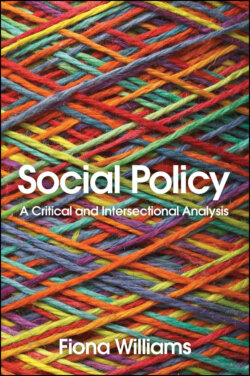Читать книгу Social Policy - Fiona Williams - Страница 23
The crisis of climate change and ecology
ОглавлениеThe third global crisis is that of climate change and ecology, known as the Anthropocene (Lewis and Maslin 2015): that the extent of human activity upon the planet’s resources, especially through the burning of fossil fuels, has accumulated carbon in the atmosphere and oceans to the point that, without significant intervention in the immediate term, human life is endangered through global warming. The world is already experiencing the consequences of accelerating floods, bushfires, drought, heatwaves and storms, while in the future the sustainability of the planet and the whole ecosystem is at risk (World Meteorological Organization 2019). The use of ‘anthro’ in Anthropocene implies that this is the consequence of the activity of all humanity, but processes of resource extraction and exploitation have been a central part of capitalist production and profit accumulation and, in the case of oil and coal, have literally fuelled industrial expansion. Resource exploitation – cotton, tea, coffee – was part of imperialism and colonial expansion through to global capitalism today. Some suggest that, given capitalism’s exploitative relationship with nature, a more accurate label, in terms of who is affected by that exploitation, is ‘Capitalocene’ (Gill 2019: 5) or ‘racial Capitalocene’ (Manchanda 2019: 2).
The environment and climate change raise questions of equity, equality and justice across populations and regions and over generations (Cahill 2002; Fitzpatrick 2011, 2014; Snell and Haq 2014; Gough 2017). A degraded environment affects health and wellbeing in unequal measures: while the wealthy may benefit from forms of environmentally harmful consumption, it is disproportionately poor people – nationally, regionally, globally – whose lives are impacted (Snell and Haq 2014). Poorer regions are affected incrementally by anything over a 1.5 per cent reduction target in global warming, in contrast to the ‘less than 2 per cent’ set by the Paris Agreement on Climate Change in 2016 (King and Harrington 2018). The UN’s migration agency, the International Organization for Migration, notes that, in 2018 alone, 17.2 million new displacements from disasters in 148 countries and territories were recorded (Ionesco 2019). Within these populations women suffer significantly. According to UN Women and the World Bank, in 2017 women were disproportionately in poverty in developing countries (UN Women 2017). They constitute the majority farmers and carers and are more dependent upon land and resources such as water and fuel which are threatened by climate change; they are particularly vulnerable to gender-based violence and bonded labour if displaced by disasters; and they have less political voice in decision-making (Action Aid 2019).
Further, measures to prevent global warming can also be disadvantageous to particular groups. For example, biofuel production as a replacement for oil has created greater competition for marginal agricultural land and has deprived women, especially indigenous women, of their livelihoods (Women’s Environmental Network 2019). These forms of exploitation, expropriation and expulsion are mirrored in the developed world. Carl Anthony’s book The Earth, the City, and the Hidden Narrative of Race (2017) documents the ways in the US in which racial and planetary subordination and racial and environmental injustice go hand in hand over time. This moves from the colonization of both peoples and the earth to the ways in which gentrification, expulsion and the deregulation of water and waste hit minority communities (Anthony 2017, cited in Manchanda 2019; see also Pulido 2016).
‘Environmental racism’ has been used to describe the ways in which, in Europe, marginalized and minority groups are disproportionally subjected to environmental hazards such as living in proximity to toxic waste, or having limited access to clean air, water and other natural resources (Vincze 2013). This has particularly affected the siting of Roma and Traveller people. In the UK, one report found that minority ethnic groups, by virtue of their place of residence near main roads and motorways, are exposed to 17.5 per cent higher concentrations of dangerous particulates (ENDS Report 2009: §53).
In 2019, the global pandemic of the Covid-19 virus brought the deadliest of a series of epidemics and is another form of environmental risk to sustainability. It represents a micro-biological facet of the macro-exploitation of resources affecting human health and capacity for production, and it bears similar challenging features, outcomes and lessons. It is associated with globalization, flourishing in high-density urban areas in which 68 per cent of the world population now lives (WEF 2020a). Some epidemics, such as Zika, travelled on the climate-changing winds of El Niño. Covid-19 respects neither class nor borders, yet is more deadly for older and physically vulnerable people and more devastating for socio-economically disadvantaged groups or racial minorities (see chapter 4). As with the financial crisis, the markets, always focused on the short-term, were unable to stop themselves from falling. Like climate change, the pandemic presents random, unpredictable risks. This challenges the basis of welfare states that are built on a range of relatively predictable risks. Both require robust multi-scalar global, national and local governance for interdependent political, public and expert co-operation to develop social and physical protection.
In so far as the mitigation of climate change challenges the continuation of consumerism, economic growth and exploitation of the earth’s resources, it also challenges the assumption, first, that the welfare state is afforded and legitimated only through capitalism’s commitment to economic growth; and, second, that mitigation and adaptation policies require multi-scalar forms of co-operation and expenditure (from global to local) which profoundly tax how we think about the relations between ‘overdeveloped’ and developing worlds and the development, implementation and funding of a future eco-social policy (Fitzpatrick 2014; Gough 2017). Third, climate change has constituted a challenge to anthropocentric relations of power: the assumed right of the human world to dominate and exploit the non-human world, demanding instead not only strategies to mitigate the effects of climate change but a new way of being with the interdependencies of the ecosystem.
